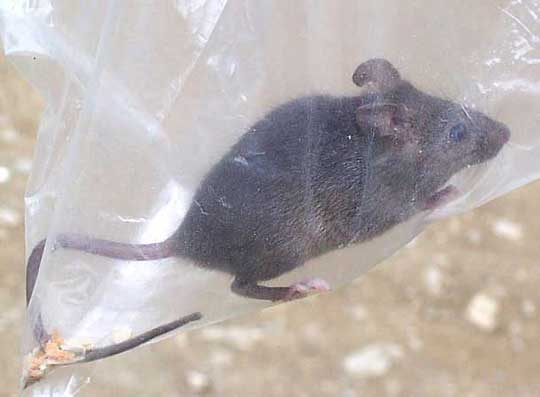Excerpts from Jim Conrad's
Naturalist Newsletter
from the June 2, 2007 newsletter issued from Sierra Gorda Biosphere Reserve, QUERÉTARO, MÉXICO
MOUSE WARS
Those of you who have been with me since my Mississippi days may recall my adventures trying to nonviolently remove mice from my tiny, book-packed trailer out in the woods. The mice were big-eyed, high-jumping White-footed Mice, native to most of eastern and central North America.
A couple of weeks ago a mouse moved into my casita here in Jalpan, and it's taken me a while to catch it. I did catch it once using the tip-bottle method that had been so successful in Mississippi, but the critter escaped and learned from the experience not to enter food-containing plastic bottles teetering at the edge of my desk. I could hardly wait to catch the mouse, anticipating that it might be a native Mexican species beautifully adapted to the scrub beyond the fence just outside the casita.
Finally at dusk the other day I saw the mouse climbing up behind a window drape and I grabbed her through the drape's fabric. I say "her" because the moment I had her in my hand I felt the plumpness of her body, and I didn't think it was all from eating my peanuts and oatmeal. I nudged her into a plastic bag and couldn't wait to start identifying. You can see her in my bag below:

Well, best I can figure out, she's a plain old House Mouse, MUS MUSCULUS. Still, even a House Mouse has "field marks," so it was interesting to review what makes a House Mouse a House Mouse.
As the table midway down the page of my Rats, Mice & Voles page at www.backyardnature.net/rats.htm shows, currently about 125 species of mousy, ratty rodents are found in North America north of Mexico. There are 17 species of deer mouse (My White-footed Mouse was a deer mouse), as well as 20 species of pocket mouse, 12 species of wood rat, 16 of kangaroo rats, 26 of voles, etc.
The vast majority of our native mice and mouse-like creatures have white fur on their bottoms, like my earlier White-footed Mice. Therefore, an important feature of the House Mouse, which is a native from the Mediterranean area through Asia, is that its bottom fur may be a tiny bit paler than its top fur, but it's not really white. Moreover, the tops of its feet are gray, not white. Tails of most native mousy species are bicolored -- dark on top but white below. Also, the House Mouse has relatively smaller eyes than most of our native mice.
I released my Mus musculus down next to the reservoir in a vine-overgrown stone fence near where visitors throw their garbage. I assume that the area already is occupied by the species and this one, being away from her scent trails and in unknown territory, will fall easy prey to one of our abundant pygmy owls or roving house cats.
There's a lot of information about the House Mouse here.